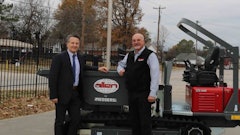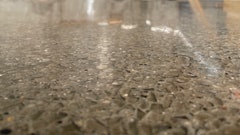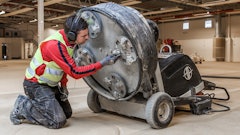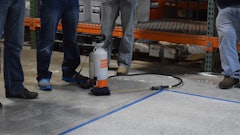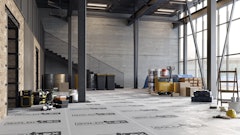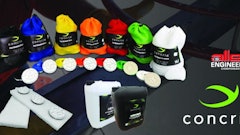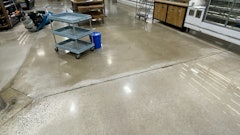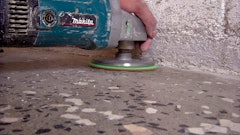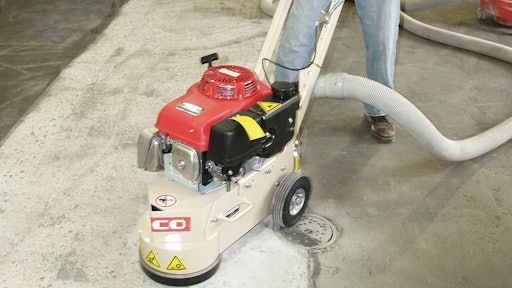
Q: What is the most efficient way to level concrete floors and/or remove coatings from the surface before beginning the polishing process?
A: Choosing the right tools and performing careful surface preparation before starting the polishing process creates ideal polished concrete floors. Uneven surfaces and old coatings hinder the final appearance of polished surfaces, dulling shine and clouding reflectivity. Scarifiers and turbo grinders both level concrete and remove coatings.
Scarifiers are aggressive machines designed for removal. They quickly level uneven surfaces like sidewalk trip hazards and truck bumps. Turbo grinders quickly level high spots like expansion joints and bridge decks. Both machines will also remove thick, hard coatings that must be removed from concrete surfaces in order to achieve high shine and reflectivity. (Note: Maximum shine and reflectivity is not always needed.)
The difference between scarifiers and turbo grinders are aggressiveness and surface finish. Scarifiers are more aggressive than turbo grinders, leveling/removing faster. Scarifiers however, leave a textured surface, unfriendly to polishing. While turbo grinders level/smooth a bit slower, they create smooth surfaces ready for the polishing process.
Teaming scarifiers and grinders together provides aggressive leveling/removal (scarifier) and smoother surfaces (turbo grinder). Every situation involving heavy surface preparation is different. Sometimes both, only one or none of these machines are needed. If needed, these kinds of tools will create an ideal surface to begin polishing.
Ray Tucker, Customer Service Manager
EDCO - Equipment Development Company, Inc.
Q: I have to fill the joints in my polished floor project with a semi-rigid polyurea or epoxy joint filler. When during the polishing process is the ideal time to do my joint filling?
A: Generally speaking, when using a polyurea joint filler we recommend filling the joints just before your last metals cut on the floor. Our experience has been that the last metals cut is typically aggressive enough to remove any filler overfill film or residue that may remain on the concrete surface after the overfill has been razored off, but not so aggressive that the filler is gouged or chunked out during the grinding process. The last metals cut can also help reduce minor concavity in the finished profile of the filler if the ideal flush shave window was missed during the installation process.
If you are asked to fill the joints after completing the polishing process, it will generally be necessary to mask the edges of the joint with painter’s tape or a stain prevention film to prevent the filler overfill from dulling the polished surface or removing a stain guard if one has been applied. Masking the joints will be essential if you are installing a semi-rigid epoxy joint filler before or after polishing as epoxy filler overfill will leave a residual stain in unprotected concrete. Installing either epoxy or polyurea joint filler prior to the start of the polishing process will generally not prove problematic, as long as the first cut is no more aggressive than 80 metals.
Scott Metzger, President
Metzger/McGuire
Q: Is it legally safe to dispose solidified slurry in the trash can?
A: In the construction industry, sometimes dealing with concrete slurry is unavoidable. Unfortunately, concrete slurry waste is prohibited from being dumped straight down the drain, due to its harmful nature. After using a slurry solidifier, it is completely legal and compliant with Environmental Protection Agency (EPA) standards for contractors to toss the resultant material straight into the dumpster.
The material must pass one of the most important tests, the EPA Method 9095B Test. Within a five minute test period, nothing can pass through a paint filter, or the material is deemed to contain free liquids. If free liquids are present, then the material is unacceptable in landfills.
The EPA states that free liquids can be placed in a landfill if all of it has been “solidified so that free-standing liquid is no longer observed or has been otherwise eliminated”[1]. Some landfills might question the disposal of the solidified slurry because of their unfamiliarity with the material; however, EPA documentation states that is perfectly acceptable for landfills once it is completely solidified.
Furthermore, only certain slurry solidifying brands (such as Gelmaxx) are acceptable for landfills because of the Toxicity Characteristic Leaching Procedure (TCLP). This is a sample method for chemical analysis used to simulate leaching in a landfill. In other words, the TCLP determines whether the liquid that excretes from the solids will carry any environmentally harmful substances. Make sure to get a product that encapsulates the heavy metals and keeps the slurry from emulsifying and leeching into the landfill. However, please keep in mind that if the concrete slurry has harmful toxins before solidification, it will still be considered hazardous after solidification.
Now is it legally safe for contractors to dispose solidified concrete slurry directly in the dumpster? Yes, because it abides by all the EPA standards for proper liquid waste disposal.
Paul Nguyen, Marketing & Sales Associate
GelMaxx Slurry Solutions
Q: What can be done to take away discoloration from screed lines, disparate aggregate sizes, and rust or tile stains when grinding to prepare for polished concrete on a new or existing slab?
A: Unfortunately there is no guarantee that grinding can remove any difference in concrete coloring. The contractor/owner must be aware of this from the onset of any project.
Common causes of color variation can be rust stains or VCT stains that leave a grid like pattern in the concrete after the contractor removes the old tile. Other variations may be exposure of aggregates and sands in the concrete slabs that are unfavorable to the owner or architect. Also, though considered very hard, concrete is actually like a sponge. Stains like rust and oil-based contaminants can seep into concrete 1/4 inch or more. A 1/4 inch of concrete would be an expensive amount of concrete to remove if a customer is only budgeting for a "sand" type polish, possibly making the project uneconomical to achieve. Inequalities in aggregate sizes and concentration would, for the same reason, be uneconomical and still not achieve the desired result.
The only way to determine that a satisfactory result can be reached is to perform a mock-up, which is doing the proposed process on a given slab that will be a representation of the area to be ground and polished. This will give the applicator and owner the best guide of what can be achieved with the in-place slab, thereby dictating the process that must be used, and also, that the customer's expectations can be met before any further work is done. This is the surest way to meet the customer's expectations after the sales process is complete but before the expensive phase of installation begins.
Josh Jones, President
Substrate Technology, Inc.
Q: I followed your data page exactly. Why isn't your densifier working?
A: As a manufacturer of products for the finished concrete industry, this question hits my desk at least three to four times a week. When we (manufacturers) develop a product, we go through a very long and lengthy process before introducing it to the market. We hold weeks and months of testing, not only in our lab but also in field trials with applicators. When we launch a product that has passed all of these steps, we take great pride in the fact that it has been “field tested, with laboratory results backing it." But like all products in all industries, we cannot count on everything to be perfect all the time.
When I receive this distress call, the first step in solving this is to gather information, from you, the contractor. Since each jobsite is different and since we have different climates and conditions throughout the country and the world, here are a couple of suggestions and tips to go over.
1) Moisture situation. Is your humidity high or low? Was there a previous floor installed like VCT? Did you polish/grind wet? High moisture in the slab, whether from just being uncovered from VCT or from existing floors, will necessitate your densifier be used at a higher rate. Moisture can also cause a floor to release “salts” for an undetermined amount of time. Typically when you have salts come to the surface this is a sure sign of a high moisture situation where the densifier may not be able to fully penetrate the surface.
2) Was the floor hard to grind? Was the floor falling apart and diamond use high? The floor could have experienced carbination during the initial place and finish of the slab (CO2 mixes with the concrete during finsihing and creates a weak and sometimes dusty surface). Or the floor is extremely soft and you may need multiple applications of the densifier to rebuild the surface. When faced with this, don’t go at it alone — contact your manufacture.
3) Does the floor have pin holes in the surface? Pin holes will prevent a floor from achieving a gloss or proper finish per the specifications. Some floors need to be treated with a product like our Grind-N-Fill and/or grout coated.
4) What is the function of the floor going to be? The specification on the project may actually be the wrong specification for the use of the building. Check to see what you are actually providing based on a floor function.
Ask yourself to answer these above questions on every job that you are on or you are thinking about starting on. While we cannot foresee every condition, I bet that by working together as a team and finding the common culprit, we can find out what is happening to you, and more importantly your floor, AND get you out of any situation.
Remember this, each floor done by each and every applicator affects the industry and through working together each situation can add knowledge to our industry. Happy Flooring.
[1] Authenticated US Government Information, p. 473. http://www.gpo.gov/fdsys/pkg/CFR-2010-title40-vol25/pdf/CFR-2010-title40-vol25-sec264-314.pdf






